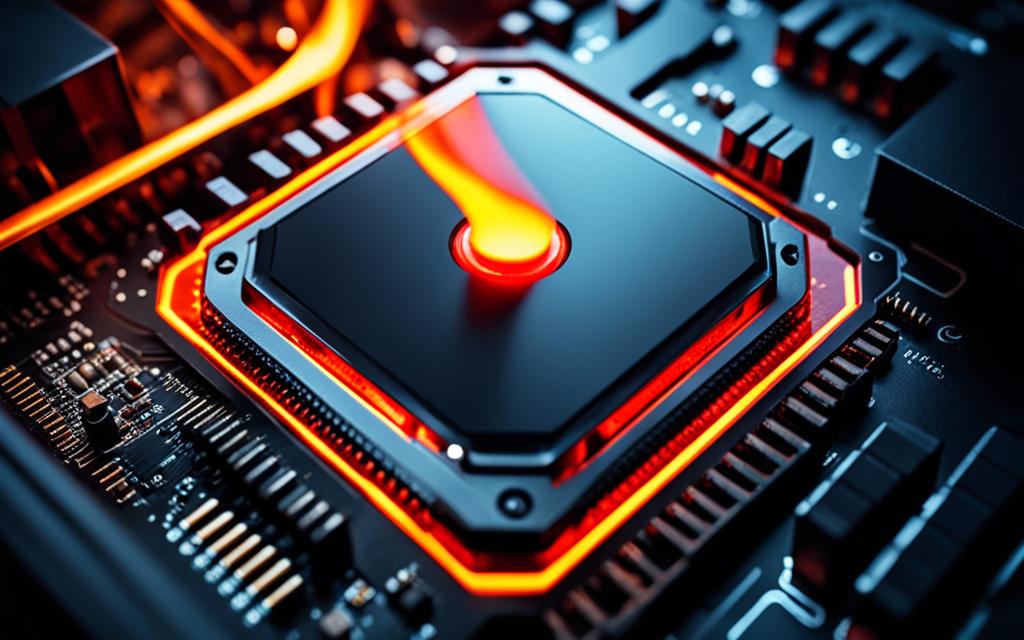Table of Contents
In the world of tech, high CPU temperatures are a big worry. It’s key for all users to know the dangers of an overheating CPU. This helps keep your computer working well and makes the CPU last longer. Normally, it’s best if the CPU stays below 60°C (140°F) to prevent damage. During tough tasks, temperatures between 70° to 85°C (158°F to 185°F)1 are common.
But, if the heat goes over 90°C (194°F), serious harm that can’t be fixed could happen. This also affects how well the system runs and the life of its parts2. This piece explores why CPUs get too hot. It gives tips on how to keep an eye on this and manage the heat well. This keeps your computing experience safe.
Key Takeaways
- The ideal CPU temperature for performance is under 60°C.
- Normal temperature ranges during intensive use are from 70° to 85°C.
- Temperatures above 90°C can lead to catastrophic failure.
- Maintaining regular checks can help prevent CPU overheating.
- Effective cooling solutions can significantly enhance thermal management.
- Regular maintenance and cleaning are essential for optimal performance.
Introduction to CPU Temperatures
Keeping an eye on your CPU temperature is vital in the world of computer hardware. The ideal temperature for a CPU is specific and important for it to work well. When not doing much, CPUs should be between 30-40 degrees Celsius3. Doing simple tasks, the temperature might be 40-60 degrees Celsius. But playing games can make it jump to 60-85 degrees Celsius. More demanding work, like video editing, can push it even higher, to 70-95 degrees Celsius3. This shows why managing heat is essential to keep your computer running smoothly and prevent it from getting too hot.
Many things affect how hot your CPU gets. This includes the room temperature, how hard the computer is working, how good your cooling system is, if you’ve increased your computer’s speed (overclocked), and the air flow in your computer case3. Making sure your computer has enough air and is clean can help it stay at the right temperature. Using programs like HWMonitor or Core Temp to watch your CPU’s temperature is critical. If the temperature goes over 90-100°C, your computer might work less efficiently or even get damaged3.
Better cooling, like air or liquid systems, can really help control your CPU’s heat. This makes your computer more stable and reliable. Knowing about these systems can help you stop overheating before it causes trouble. This way, you can enjoy using your computer without worry.
- Most CPUs should run between 40-70 degrees Celsius under normal use3.
- Idle CPU temperatures range from 30-40 degrees Celsius3.
- Gaming can elevate CPU temperatures to 60-85 degrees Celsius3.
- Intensive tasks can push temperatures to 70-95 degrees Celsius3.
- Effective CPU cooling systems are crucial for temperature regulation3.
What’s a High CPU Temperature?
It’s vital to know what a high CPU temperature means for your computer’s health. Monitoring your CPU’s heat helps avoid big problems and costly fixes. Generally, you want your CPU cooler than 60°C (140°F) for the best performance1.
When you push your computer hard, like in gaming, CPU heat can go up. It might reach 70°C to 80°C (158°F to 185°F) during these heavy use cases1.
General Temperature Guidelines
Heat above 90°C (194°F) can seriously damage your PC1. Most CPUs do well between 40°C to 65°C for everyday tasks2. Owners of AMD chips, like the Ryzen 5 3600X, should aim to stay under 65°C for longer life4.
Signs of Overheating
If your PC is overheating, you’ll notice it. Signs include slower performance, sudden turn-offs, and louder fan noises. Overly warm CPUs might slow down on purpose, to cool down2.
These issues can really affect your work or fun, making things like videos or games less smooth4.
Causes of High CPU Temperatures
Knowing why CPU temperatures rise is key to keeping a computer running well. Many things can make your CPU get too hot, affecting how well it works. By understanding these reasons, you can take steps to keep your system running smoothly and last longer.
Overclocking Effects
When you overclock a CPU, it heats up more. Pushing it past its limits means it might get hotter than 80°C (176°F). This can harm your CPU5. It’s important to watch the heat levels, especially when doing heavy tasks.
Environmental Factors
Where your computer sits can really affect its temperature. Being in a warm room or a tight space can make cooling harder. If your computer is in a spot with no air flow or in the sunlight, it could overheat easily6. It’s crucial to think about where you place your computer for the best performance.
Dust and Airflow Issues
Dust buildup can badly affect your computer’s cooling system. It can block fans and heatsinks, making them less efficient at getting rid of heat. That’s why keeping your PC clean is important to avoid getting too hot and slowing down.
- Dust filters, which cost about $50, can help keep your computer cleaner.
- Using electric compressed air dusters, priced around £30, saves money in the long run compared to buying canned air.
- Keeping airflow in your PC case balanced is key. Negative airflow can pull more dust in, which might shorten your PC’s life.
How to Check CPU Temperature
Learning how to check your CPU’s temperature is crucial for keeping it running smoothly. There are software and manual ways to check it accurately. Each approach has its benefits, helping you keep an eye on how hot your CPU is.
Using Software Applications
Many software tools can help you monitor your CPU’s heat. Some well-known ones are Core Temp, HWMonitor, and NZXT CAM. They let you see your CPU’s temperature in real-time. Ideally, your CPU should be cooler than 50°C when idle and under 80°C when working hard7. Though CPUs can get quite hot and still work, temperatures over 95°C are dangerous and may cause your computer to slow down8.
Manual Checks Through BIOS/UEFI
If you prefer doing things by hand, you can check your CPU’s temperature via BIOS. When your computer starts, you can enter the BIOS or UEFI settings. Different computer brands like Acer, ASUS, and HP use specific keys for this, such as F2, F10, or Delete9. Knowing how to monitor your CPU temperature, whether through software or manually, is key to keeping your computer safe.
Managing and Reducing CPU Temperatures
Keeping CPU temperatures low is crucial for your computer’s best performance and lifespan. There are several cooling methods like better air-cooling, liquid systems, and advanced heatsinks. These help keep temperatures safe when your computer works hard10.
Effective Cooling Solutions
If standard coolers aren’t enough, consider higher-quality options. Switching to an effective CPU cooler or liquid system with a big 360mm radiator makes a big difference. Using faster fans helps too, but they might get louder. Only 4-pin connector fans can speed up, so picking the right parts is important11.
Maintenance Tips to Lower Heat
Regular care is key to managing heat. Clean dust off all parts, like CPU and case fans, to cool better without spending much. Changing thermal paste often also helps because it wears out and doesn’t transfer heat as well. Adding or improving fans can further reduce heat, which is great for small spaces10.
Adjusting System Settings
Changing CPU settings can cut down heat. Using power-saving options or reducing CPU power use through undervolting or underclocking lowers heat. Decreasing graphics settings in heavy applications also helps. It’s important to keep an eye on your CPU’s to make sure it stays cool
Conclusion
High CPU temperatures are a big risk. They can slow down your computer and even damage it. Knowing about these dangers helps you keep your computer running well. Using the right tools and methods to cool your CPU makes a huge difference. Look at CPU temperature management for good ideas to prevent overheating.
CPUs can get really hot, around 70 to 80 degrees Celsius, if they’re not cooled properly. This can cause your computer to crash or break12. Doing simple things like cleaning out dust and upgrading your cooling system can lower the temperature a lot. This helps your computer work better and last longer13. It’s important to keep an eye on how hot your CPU is getting.
Looking after your computer well means it’ll work great for a long time. By avoiding overheating, you’ll have a smooth and reliable computer use. This makes computing enjoyable and stress-free for many years.
FAQ
What is considered a high CPU temperature?
A CPU temperature above 70 degrees Celsius is seen as too high for continued performance. If it gets to 80 degrees Celsius, it could shorten the CPU’s life. For the best performance, keep it below 60 degrees Celsius.
What are the signs of CPU overheating?
Overheating signs include slow performance, unexpected shutdowns, and louder fan noises. Reaching 90 degrees Celsius can cause thermal throttling. This results in slower performance and stuttering in heavy tasks.
How can I monitor my CPU temperatures effectively?
Use software like Core Temp, HWMonitor, and NZXT CAM for real-time temperature monitoring. You can also check the BIOS or UEFI settings at startup for an accurate reading.
What causes high CPU temperatures?
Overclocking, bad environmental conditions, and poor airflow from dust or blocked vents can cause high temperatures. Tackling these can greatly improve thermal management.
What cooling solutions are available for CPUs?
Good cooling options are better air coolers, water cooling systems, and aftermarket heatsinks. These can help manage temperatures, especially under heavy use.
How should I maintain my CPU to prevent overheating?
Clean dust, replace thermal paste, and ensure good airflow regularly. These steps can greatly improve your CPU’s temperature control and extend its life.
How can I adjust my system settings to manage CPU temperatures?
Improving performance includes using power-saving modes, lowering graphics settings, and changing operating system settings. These reduce the CPU’s workload, helping to cool it down.
Source Links
- https://www.pandasecurity.com/en/mediacenter/how-to-check-cpu-temp/ – How to Check Your CPU Temperature – Panda Security
- https://www.avast.com/c-how-to-check-cpu-temperature – How to Check and Monitor Your CPU Temperature
- https://computercity.com/hardware/processors/normal-cpu-temperatures – Normal CPU Temperatures: Guidelines for Safe & Optimal Performance – ComputerCity
- https://www.maketecheasier.com/troubleshoot-high-cpu-temperature/ – How to Cool Down a High CPU Temperature
- https://www.linkedin.com/advice/1/how-can-you-lower-your-cpu-temperature-too-high – How can you lower your CPU temperature if it is too high or overheating?
- https://www.noyafa.com/blogs/knowledge-base/good-cpu-temperature – What Is A Good CPU Temperature? A Guide to Keep Your Processor Cool
- https://www.tomshardware.com/how-to/how-to-check-cpu-temp-temperature – How to Check Your CPU Temperature
- https://softwarekeep.com/blogs/how-to/how-to-check-cpu-temp-in-windows-10-11 – How To Check Your CPU Temperature in Windows 10/11
- https://www.avg.com/en/signal/check-cpu-temperature – How to Check and Monitor CPU Temperature on Windows and Mac
- https://www.digitaltrends.com/computing/how-to-lower-cpu-temperatures/ – How to lower your PC’s CPU temperatures, from easy to expert | Digital Trends
- https://www.xda-developers.com/how-to-lower-cpu-temperature/ – How to lower your CPU’s temperature
- https://ms.codes/blogs/computer-hardware/what-is-a-high-cpu-temp – What Is A High CPU Temp
- https://forums.linuxmint.com/viewtopic.php?t=357671 – [SOLVED] High to critical CPU temp, despite low usage








